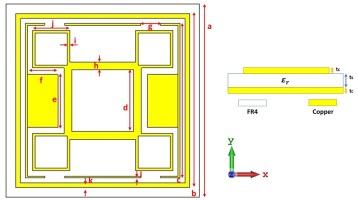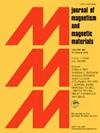Robust Multi-Band DNG metamaterial absorber for GPS (L1), ISM, and 5G application with Enhanced polarization and angle stability
IF 2.5
3区 材料科学
Q3 MATERIALS SCIENCE, MULTIDISCIPLINARY
引用次数: 0
Abstract
This research introduces a triple-band metamaterial absorber characterized by insensitivity to both polarization and incident angles. The structure includes square ring resonators on the upper side and a continuous metal ground on the lower side, separated by an FR4 substrate. At the lowest operating frequency, the unit cell’s thickness, and length measure 0.0128λ and 0.156λ, respectively. Under normal incidence, the proposed absorber demonstrates three clear absorption peaks at 1.56, 2.43, and 3.36 GHz, achieving absorption rates of 98 %, 99 %, and 97 %, respectively. The absorption response exhibits variation with incident angles up to 70° for both TM and TE polarizations due to its high-level symmetry. This configuration attains negative permittivity and permeability suitable for operational frequencies in the L-band and S-band. The study examines the electric field, impedance, and surface current to provide additional evidence for the absorption analysis. A validated RLC circuit equivalent to the proposed structure has been confirmed using Advanced Design System (ADS). The results indicate a slight deviation, especially at frequencies beyond the resonance frequencies. The structure underwent fabrication and testing in an anechoic chamber, revealing a strong correlation between the simulated and measured results. The suggested absorber holds promise for ISM applications, radar systems, sensing technologies, and energy harvesting systems.

用于 GPS (L1)、ISM 和 5G 应用的稳健型多频段 DNG 超材料吸收器,具有更强的极化和角度稳定性
这项研究介绍了一种三波段超材料吸收器,其特点是对偏振和入射角都不敏感。该结构包括上侧的方形环状谐振器和下侧的连续金属接地,并由 FR4 基板隔开。在最低工作频率下,单元尺寸的厚度和长度分别为 0.0128λ 和 0.156λ。在正常入射条件下,所提出的吸收器在 1.56、2.43 和 3.36 GHz 处显示出三个明显的吸收峰,吸收率分别达到 98%、99% 和 97%。由于其高度对称性,吸收响应随入射角度的变化而变化,在 TM 和 TE 极化下最高可达 70°。这种结构可获得适合 L 波段和 S 波段工作频率的负介电常数和负导磁率。研究对电场、阻抗和表面电流进行了检测,为吸收分析提供了更多证据。使用高级设计系统 (ADS) 确认了与拟议结构等效的 RLC 电路。结果表明存在轻微偏差,尤其是在超出共振频率的频率上。该结构在电波暗室中进行了制造和测试,结果显示模拟和测量结果之间具有很强的相关性。建议的吸收器有望用于 ISM 应用、雷达系统、传感技术和能量收集系统。
本文章由计算机程序翻译,如有差异,请以英文原文为准。
求助全文
约1分钟内获得全文
求助全文
来源期刊

Journal of Magnetism and Magnetic Materials
物理-材料科学:综合
CiteScore
5.30
自引率
11.10%
发文量
1149
审稿时长
59 days
期刊介绍:
The Journal of Magnetism and Magnetic Materials provides an important forum for the disclosure and discussion of original contributions covering the whole spectrum of topics, from basic magnetism to the technology and applications of magnetic materials. The journal encourages greater interaction between the basic and applied sub-disciplines of magnetism with comprehensive review articles, in addition to full-length contributions. In addition, other categories of contributions are welcome, including Critical Focused issues, Current Perspectives and Outreach to the General Public.
Main Categories:
Full-length articles:
Technically original research documents that report results of value to the communities that comprise the journal audience. The link between chemical, structural and microstructural properties on the one hand and magnetic properties on the other hand are encouraged.
In addition to general topics covering all areas of magnetism and magnetic materials, the full-length articles also include three sub-sections, focusing on Nanomagnetism, Spintronics and Applications.
The sub-section on Nanomagnetism contains articles on magnetic nanoparticles, nanowires, thin films, 2D materials and other nanoscale magnetic materials and their applications.
The sub-section on Spintronics contains articles on magnetoresistance, magnetoimpedance, magneto-optical phenomena, Micro-Electro-Mechanical Systems (MEMS), and other topics related to spin current control and magneto-transport phenomena. The sub-section on Applications display papers that focus on applications of magnetic materials. The applications need to show a connection to magnetism.
Review articles:
Review articles organize, clarify, and summarize existing major works in the areas covered by the Journal and provide comprehensive citations to the full spectrum of relevant literature.
 求助内容:
求助内容: 应助结果提醒方式:
应助结果提醒方式:


